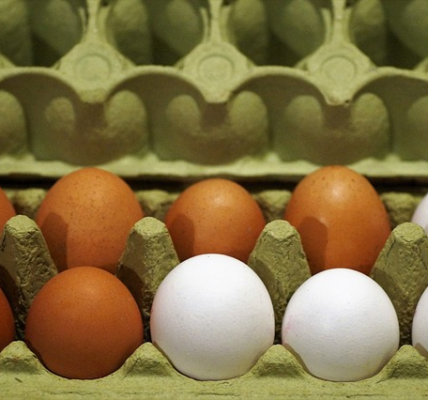Ina, Emeril, Giada. Mashama, Vivian, and Kwame. Today, we’re all blessed with a seemingly-endless library of free online cooking lessons from chefs who are so world-famous, they only need one name. But long before those celeb chefs graced our small screens, most of us learned our very first cooking lessons at home from a couple other one-name chefs: Mom and Dad.
I’m forever grateful for the cooking lessons taught to me growing up by the cook in our house, my mom, who tirelessly managed to get a well-balanced meal on the table for a family of six nearly every night for decades.
But in the years since, food trends have come and gone. Scientific studies have taught us a lot more about germs. Persistent urban legends have been disproven. And within seconds, we can access cooking tips and tricks from the world’s best chefs on every TV, laptop, and phone screen at our disposal.
So it only makes sense that we may still have some vintage cooking practices inherited from our well-intentioned parents … that are actually wrong. Here are the most common bad habits, as well as how to turn them into better ones for better-tasting, healthier cooking.
#1: Defrosting Meat And Poultry On The Countertop
Growing up, I remember coming home from school and seeing chicken breasts or packages of ground beef thawing on the kitchen counter for dinner. Others may have learned to speed up how quickly their meat defrosts by soaking it in hot water.
But these days, we’re much more aware of how quickly harmful microorganisms can multiply at room temperature. (And no, cooking can’t destroy them all.) The USDA warns that using these methods to defrost frozen meat aren’t safe because the outer layer of the meat will reach the “danger zone” of 40 to 140 °F (where bacteria multiplies rapidly), while you’re still waiting for the frozen center of the meat to thaw.
The Better Habit
Defrost meat, poultry, and seafood in the refrigerator overnight to ensure that they never sit at temperatures where harmful bacteria thrive.
#2: Neglecting Your Kitchen Knives
Seeing a full set of gleaming kitchen knives displayed in a fancy wood block on a kitchen countertop is a relatively recent trend. A few decades ago, the average home cook likely had just a couple of budget-friendly knives that they’d add to the dishwasher to clean, then unceremoniously toss in a crowded kitchen drawer for storage.
Today’s knife sets can be quite the investment, though, so you want to make sure to take care of them to make them last for years. That not only includes how you wash and store them, but how to maintain them too.
The Better Habit
Start by using a honing steel every time you use a knife to keep it aligned, and get your blades sharpened regularly to maintain their edge. Here are a few additional pointers:
- Handle with care. Hand wash all kitchen knives, then thoroughly dry them to prevent rust and other damage to the blade. (It might be easier to throw them in the dishwasher, but spending an hour or more of a high-heat dishwasher cycle will wear your blades out much faster than cleaning by hand.)
- Don’t let them linger. Never let your blades sit at the bottom of a sink, where they can accumulate build-up from food debris, and the blades can easily get broken or chipped by heavy dishware or pans.
- Store properly. Knives should be stored in a wooden knife block, magnetic strip, individual sheaths, or other storage method that keeps the individual knives separated and away from other utensils that might bump up against them and dull their blades.
#3: Pressing Meat Into Grill Grates
Perhaps you saw your own mom or dad do it while grilling, or maybe it was all those TV sitcoms and commercials. But somewhere along the way, we were taught that getting an audible “sizzle” by pressing juicy burgers onto the searing-hot grates of a grill was a good thing.
And that sizzle sound can be weirdly satisfying, right? The truth is, anytime you hear liquid sizzling on the grates, coals, or flames of a grill, you’re sending the juices that make burgers, steaks, and other meat, poultry, and seafood plump, juicy, and flavorful straight down into the flames.
The Better Habit
To avoid dried-out meat, resist the urge to press your steaks and burger patties into the grill grates. For the juiciest results and the best sear, let them sit without moving until they’re ready to flip.
#4: Tossing Out Pasta Water
Until recent years, no one but professional chefs and in-the-know Italian grandmothers were saving their pasta water. Now thanks to celeb chef-hosted television shows and online cooking lessons, word has spread: this most humble liquid can help transform a pasta sauce thanks to the starch it leaches from your spaghetti, penne, or bow ties during cooking. So stop sending all that liquid gold down the drain.
The Better Habit
Just before draining your pasta, use a coffee mug to scoop pasta water from the top of your pot. Then pour the liquid into your sauce a little bit at a time until you get your desired consistency.
#5: Washing Raw Chicken In The Sink
Who knows where this bad cooking habit started. But if you’re a child of the ’80s or ’90s, you’re probably no stranger to seeing a parent awkwardly wrestling a raw chicken or turkey under the running water of a kitchen faucet.
Not only is it easy to fumble a slippery whole bird you’re trying to rotate around under the water faucet, but this habit actually does more harm than good. Store-bought raw poultry doesn’t benefit by being rinsed before cooking. Doing so actually spreads messy, germy raw chicken from your hands to the sink, faucet, and handle (ick) as well as surrounding surfaces and any other nearby food ingredients (double ick).
The Better Habit
If cooking a whole bird, remove any packaging and giblets from the cavity. Trim your whole chicken, turkey, or poultry parts, then continue with your meal prep without the germ-spreading dunk under the kitchen faucet.
#6: Forgetting To Use A Meat Thermometer
Whether my dad was grilling his famous pork chops or my mom was cooking absolutely everything else, I never saw either of my parents use a meat thermometer growing up. Instead, they eyeballed it, or cut into a piece of meat to check how done the center was.
But it doesn’t take much to overcook a pricey piece of filet mignon. And cutting into a nice piece of chicken or steak straight from the oven or grill just makes you lose those precious juices.
The Better Habit
Two meat thermometers are better than one: that way if you’re in the middle of a dinner party and you realize one died on you, you’ll have a backup. While they’re a bit more pricey than the old-school instant-read thermometers with the large dials, it’s best to go with the digital variety since they’re faster and more precise.
#7: Adding Oil To Pasta Water
A lot of home cooks used to subscribe to the popular myth that adding oil to a pot of boiling pasta would keep the noodles from sticking together. Not only does the oil, which floats on the surface of the water, not prevent sticking. But the slick oil actually prevents sauce from adhering to the pasta when mixed.
The Better Habit
Stir the pasta regularly during the first few minutes of cooking to keep individual strands or pieces from sticking together.
#8: Believing In The Five-Second Rule
Maybe it was a childhood friend — not your older-and-wiser parents — who told you about the “five second rule,” the decades-old belief that when food hits the floor and you snatch it up in less than five seconds, it’s still safe to eat.
The notion is so popular, in fact, that many studies have been conducted to determine if the “rule” is actually fact or fiction. Researchers at Rutgers evaluated the effect of different types of food falling on surfaces including ceramic tile, wood and carpet. And while the results varied by the type of ingredient and surface tested, results proved without a doubt, bacteria can transfer to food instantaneously. In less than one second, it can pick up enough dangerous bacteria to make eaters ill.
The Better Habit
If you ever flip something in your skillet that ends up on the floor (or any other potentially contaminated surface), just throw it out. It’s smarter to play it safe than to eat it and risk getting sick.
Alison Miksch
#9: Treating Cast Iron Like the Rest Of Your Cookware
Cookware is durable by definition, and most skillets and saucepans benefit by a sudsy soak after cooking.
Maybe you were lucky enough to have a parent or grandparent teach you that cast iron requires a little special care. But the rest of us might not realize that there are some big “don’ts” when it comes to cast iron. Soaking it in water, using soap to clean it, and scrubbing it with an abrasive tool can eat away at the pan’s “seasoned” surface and lead to rust.
The Better Habit
While cast iron may require a little extra TLC when compared to other pans, it’s even distribution of heat and ability to sear like nothing else make it totally worth the special cleaning and maintenance.
If you follow our easy primer and clean it with water — or water and a very small amount of soap — and maintain its surface with regular seasoning, that trusty cast iron pan can last for decades. You may even be able to pass it down to your own kids.



